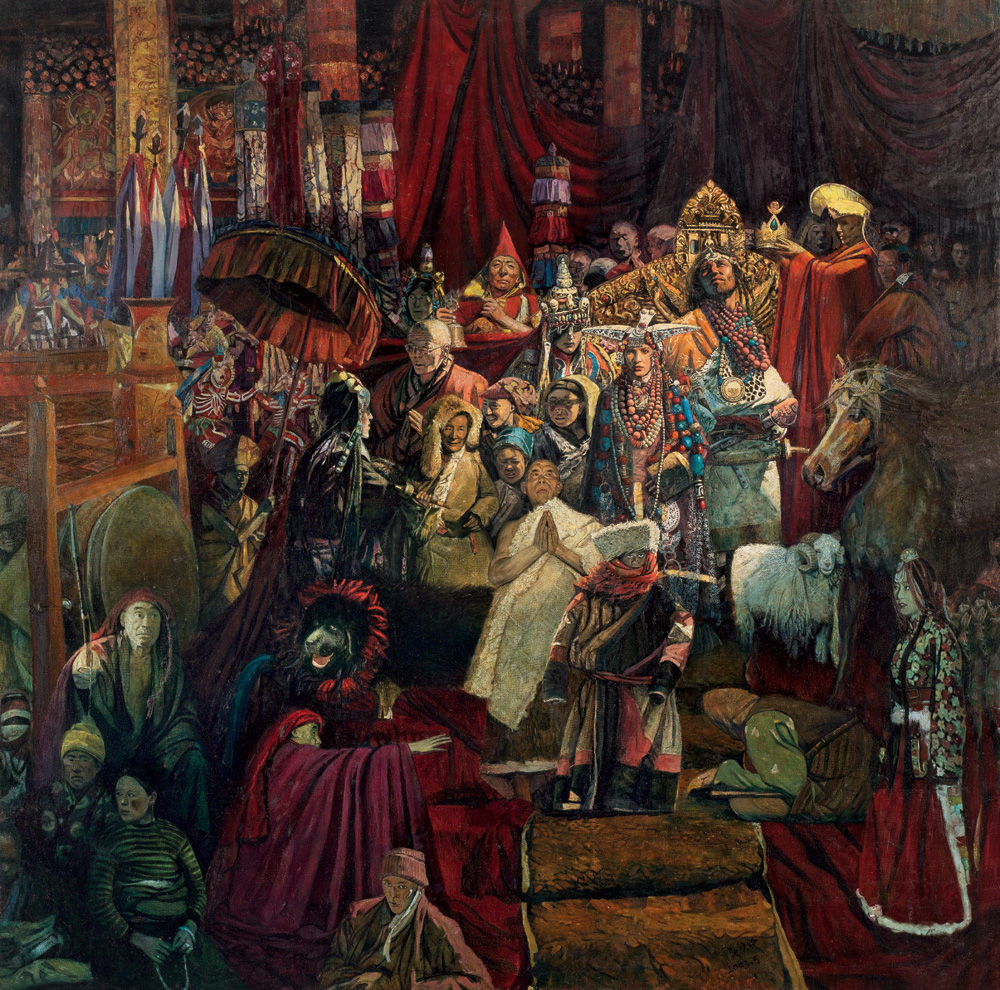Develop folk literature studies in modern China

The Tibetan opera King Gesar, depicted in this painting, was included in UNESCO’s list of intangible cultural heritage in 2013.
On June 13th to 14th, the Symposium on the Protection of Folk Literature and Intangible Cultural Heritage convened in Beijing. The symposium was jointly sponsored by the Department of Intangible Cultural Heritage in the Ministry of Culture and Minzu University of China.
In China, folk literature is often associated with myths and proverbs. Its actual genres generally fall into three categories: verse literature, including sacrifice addresses, eulogies, wedding addresses and proverbs; narrative literature, including myths, legends and folktales; and comprehensive literature, including epics and folk songs. All of this folk literature is primarily transmitted orally—either spoken or sung—in ethnic languages and dialects. Sometimes it is even supplemented with dancing.
Scattered across China’s ethnic societies, folk literature is a virtually omnipresent element of ethnic social life. One scholar even described it as “giving a name to the forms of living.” Ma Shengde, deputy director of the Department of Intangible Cultural Heritage, elaborated on its societal function. “Folk literature not only records different ethnicities’ origins, histories, ancestors and achievements, but also transmits and explicates the traditions of each nationality’s social practices, aesthetics and the formulation of their unique conceptions.” Ma said the second function “is an important manifestation and expression of the cultural variety among the many ethnicities in China and these ethnicities’ identities.”
At present, the Ministry of Culture has affirmed ten different categories in the List of National Intangible Cultural Heritage. Due to its significance, folk literature has been given special weight in comparison with traditional music, dances, operas, folk arts, fine arts and medicine.
One scholar attending the symposium said that folk literature is a special form of literature, a comprehensive artistic medium and an important cultural phenomenon. It not only has its own special content and art forms, but also has particular performance processes and modes of transmission, the scholar continued. He added that since the study of folk literature has established close ties with other disciplines—literature and art, cultural history, ethnology, anthropology and linguistics—and theories within those disciplines, there has been much more emphasis on the preservation and passing down of folk literature.
Urbanization and the spread of economic commoditization have transfigured folk culture immensely; it is not an exaggeration to say the process of passing down traditional folk culture is in crisis. This state of crisis though, is not enough to impede the unstoppable transition from an agricultural to a modern society, and the correspondent changes in modes of production that this transition inevitably entails. Currently, the preserving of folk literature and the process of passing it on to current and future generations are coping with new challenges.
In the face of these challenges, China has been developing a series of projects to protect its folk literature for some time. These efforts have recently born significant results. In 2009 a major cultural project was brought to fruition with the completion of three extensive collections—one on folk tales, one on ballads and one on proverbs. Preliminary statistics indicate that roughly 1,840,000 folktales, 3,020,000 folk songs and 4,780,000 folk proverbs are recorded in the three collections. Additionally, this year the Tibetan Epic of Gesar, the Khalkha (a Mongolian ethnicity) Epic of Manas and Nanai Epic of Yimakan were officially included in UNESCO’s Representative List of the Intangible Cultural Heritage of Humanity and List of Intangible Cultural Heritage in Need of Urgent Safeguarding.
The collection and research of Chinese folk literature entered into a modern academic stage after the New Culture and May Fourth Movements. Since the foundation of the PRC, the government has established a specific research institute for collecting and sorting relevant resources, a product of which has been the establishment of a theoretical framework for the place and collection of folk literature and arts in China.
In terms of specific cultural conservation practices, we should put preservation of folk literature at the center, said Chen Yongchao, a professor in the Department of Chinese Language and Literature at Peking University.
One attendee encapsulated the general spirit of the symposium with his remark, “There is more to protecting the folk literature than extending the historical memory of folk culture. Folk literature provides abundant resources for the present day artists in China.”
The Chinese version appeared in Chinese Social Sciences Today, No. 463, June 17, 2013
Translated by Zhang Mengying
